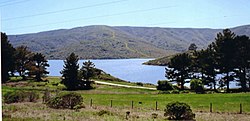San Andreas Lake
| San Andreas Lake | |
|---|---|
 |
|
| Location | San Mateo County, California |
| Coordinates | 37°35′36″N 122°25′27″W / 37.5932°N 122.4241°WCoordinates: 37°35′36″N 122°25′27″W / 37.5932°N 122.4241°W |
| Type | Reservoir |
| Primary inflows | San Andreas Creek |
| Primary outflows | San Andreas Creek |
| Catchment area | 4.4 sq mi (11 km2) |
| Basin countries | United States |
| Max. length | 4.8 km (3.0 mi) |
| Surface area | 550 acres (220 ha) |
| Water volume | 19,027 acre·ft (23,469,000 m3) |
| Surface elevation | 453 ft (138 m) |
| Settlements |
Millbrae, California San Bruno |
| References | U.S. Geological Survey Geographic Names Information System: San Andreas Lake |
San Andreas Lake is a reservoir adjacent to the San Francisco Peninsula cities of Millbrae and San Bruno in San Mateo County, California. It is situated directly on the San Andreas Fault, which is named after the valley it is in.
After discovering San Francisco Bay from Sweeney Ridge on November 4, 1769, the Portolà expedition descended what Portolà called the Cañada de San Francisco, now San Andreas Creek, to camp in the vicinity of today's San Andreas Lake.
The next day they reached a "Laguna Grande" which today is covered by the Upper Crystal Springs Reservoir. The campsite is marked by California Historical Marker No. 94 "Portola Expedition Camp", located at Crystal Springs Dam, on Skyline Boulevard, 0.1 mi south of Crystal Springs Road. They camped here a second time on November 12, on their return trip.
Padre Palóu, on an expedition from Monterey to explore the western side of San Francisco Bay led by Captain Fernando Rivera y Moncada, renamed Portola's Cañada de San Francisco to Cañada de San Andrés on November 30, 1774, it being the feast day of St. Andrew.
Captain Juan Bautista de Anza, after forging the first overland route from Monterey, California to San Francisco Bay, explored the peninsula and selected the sites for Mission San Francisco de Asís (Mission Dolores) and the Presidio of San Francisco. De Anza returned to Monterey via the Cañada de San Andrés and camped on the banks of San Mateo Creek on March 29, 1776. In de Anza's diary on March 29, 1776, he wrote: "Night having fallen, at a quarter past six I went down to the arroyo of San Andreas and to another, that of San Matheo, where it descends to empty into the estuary..."
...
Wikipedia
